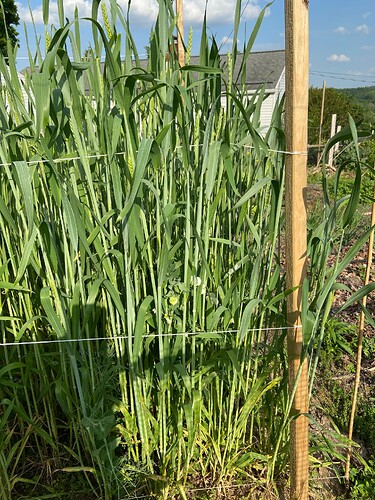I became interested in landrace wheat varieties in the 1990’s. My thought was to be able to grow my own grain in the garden, as a cover crop but also for food. The greater straw production of the old varieties was an attractive by product, good for mulching.
I was able to request seed from the USDA seed bank. They were maintaining a number of old Ohio wheats, from before 1930. At the same time I learned how to cross wheat. I thought if I crossed the different varieties, I could start a new landrace adapted to current conditions. Here’s a photo of my wheat crossing, using the approach method:
As I learned more about wheat in the local agricultural university library, I thought it would be useful to broaden the genetics of my landrace. I crossed in some landraces, also from USDA, that came from other countries with a similar climate to Ohio.
I also did crosses with durum wheats, and triticale. These were more distant crosses, disrupting the wheat genome more, and required several generations of back crossing to wheat to get back to a productive plant.
Modern bread wheat is thought to have originated from a spontaneous cross between cultivated emmer wheat (a type of durum), and a wild goat grass (Ae. tauschii) growing as a weed in the field. Cold hardiness and tolerance of poor soils, as well as the gluten that makes bread possible, came from the goat grass. I was able to make this cross as well, with the help of seeds from USDA, and scientific articles from the ag library. I only got a few crossed seeds, but I know I succeeded as the plants were completely different from both parents. Photo of the F-1 plant, and later back crossing to wheat.
The early generations were somewhat like spelt, except the seeds were even more covered with husks that were difficult to remove, and the rachis was brittle so that the spikelets would break off very easily, like a wild plant reseeding. It took many generations of back crossing to “normal” wheat to get a tough rachis and easy threshing.
Over the years I’ve selected for vigor, seeds that look like hard wheat, strong stems, and awnless heads. I plant in fall here, early to mid October. I don’t broadcast, I plant in a grid of 5-6 inches spacing. This allows strong fall growth with a lot of tillers. It also lets me evaluate individual plants for crossing. This is my wheat (with dwarf winter peas) in March.
I have selected for stem strength by weighing the dry stem at harvest (after heads removed) and dividing by the measured height. Since I have a gram scale for weight, but measure the height in inches, I get a number that is grams per inch. I mainly do this for plants I might use for crossing the next year, after selecting the plants with the best stems by eye.
I found this necessary, because the tallest plants tend to dominate, and the if they lodge they take down the better shorter plants. Also I would like to grow winter peas on the wheat, and stronger stems also mean more biomass for the garden. This is a photo of some of the better stem plants on May 15, 2025.
Two days later we had a severe thunderstorm with 50-60 mph wind gusts that lodged a lot of my wheat and rye, but the previous plants got through it ok. Harvest was in late June. I have to cover with bird netting because of sparrows. I had about 100 F-1 plants from crosses I did last year. Here is a photo of one of the crosses that was most promising, that I hand threshed out later this morning. That’s a 36 inch tall yellow yardstick.





